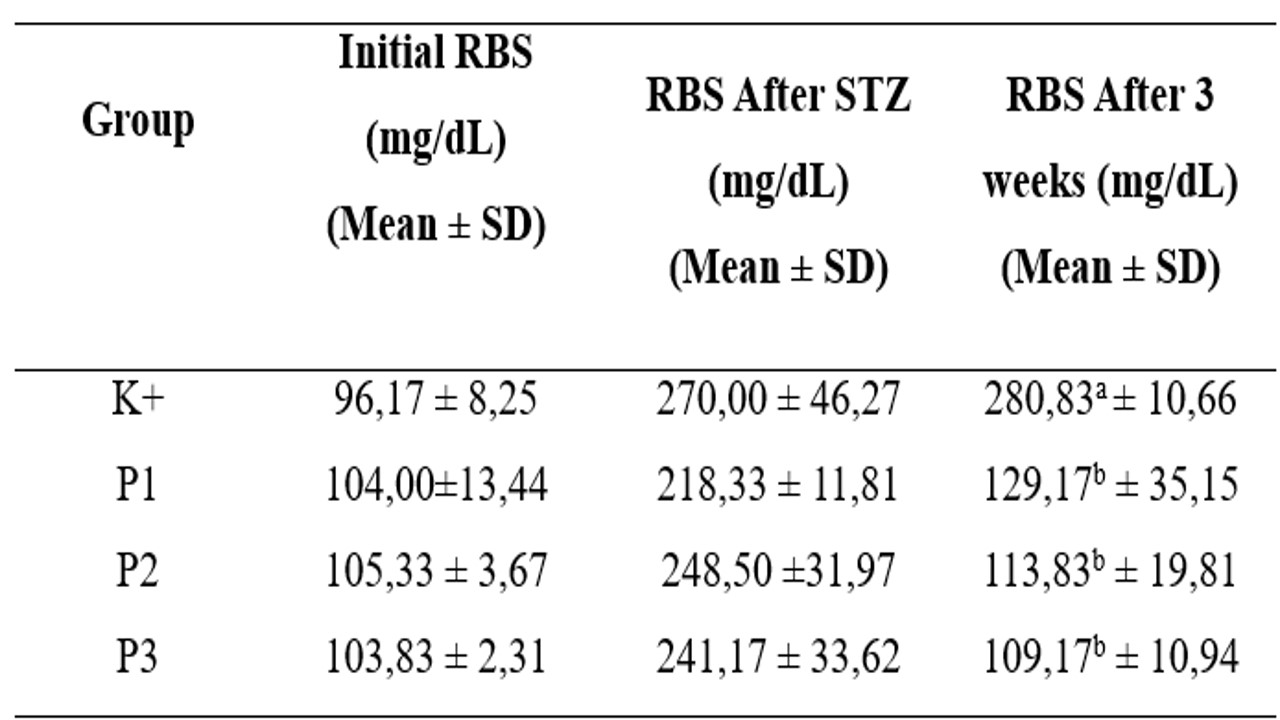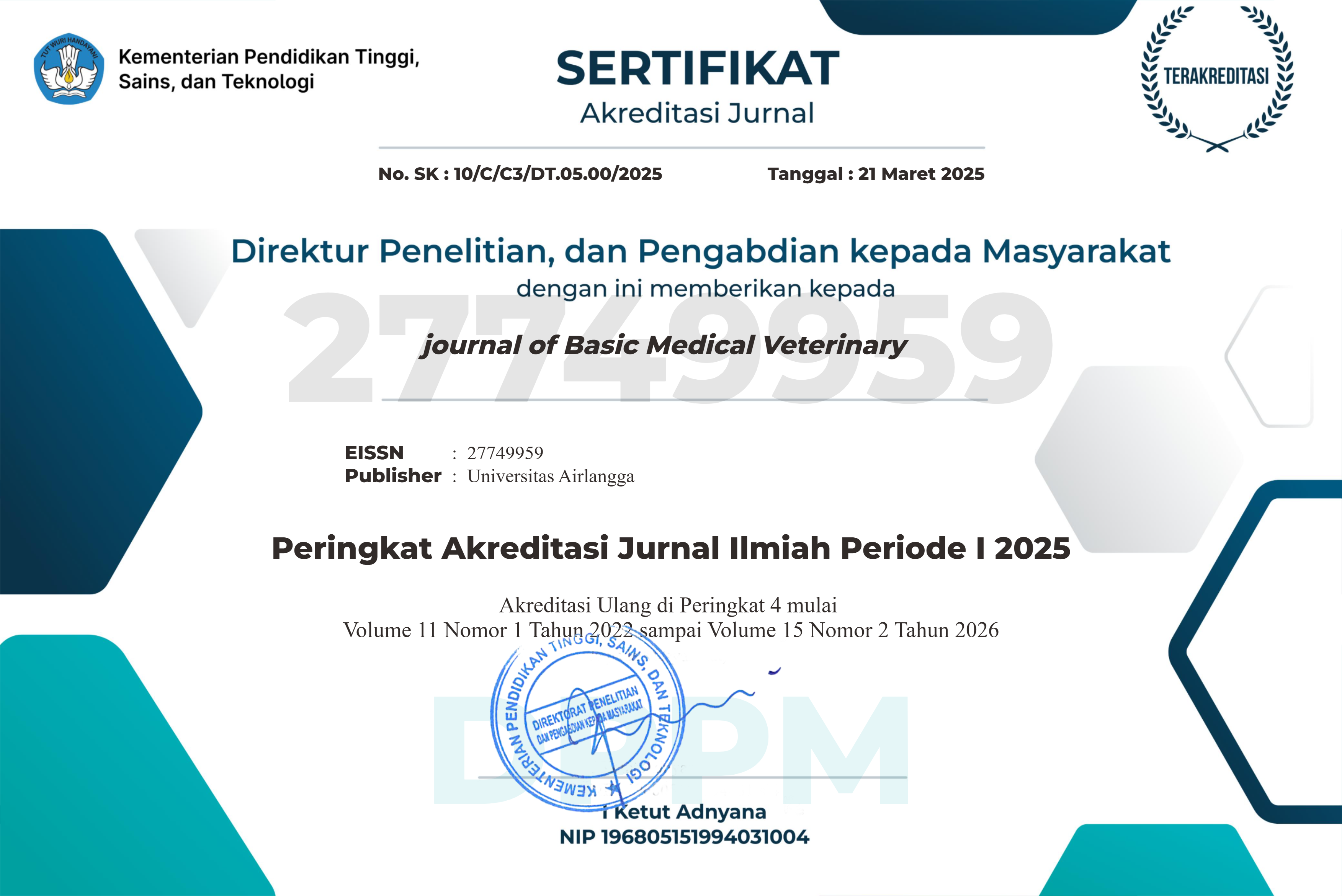Potential of Ethanol Extract of Red Curly Chili (Capsicum annuum L.) as an Antioxidant and Antidiabetic Agent in Mice

Downloads
Medicinal plants containing polyphenols (flavonoid dan tannin), quercetin and capsaicin have strong antioxidant properties. These compounds can help inhibit oxidative stress that plays a role in various diseases, including diabetes mellitus. Capsicum annuum L is rich in phytochemicals and active compounds such as flavonoids (Quercetin, Luteolin, Kaempferol), tannins, saponins, terpenoids, carotenoids, and vitamin C. This study aimed to evaluate the potential of red curly chili (Capsicum annuum L.) ethanol extract as an antioxidant and antidiabetic agent in mice. The mice will be randomly divided into the following groups (6 mice per group): Diabetic control group (induced diabetes with streptozotocin, no treatment), and Capsicum annuum L group (Diabetic group treated with Capsicum annuum L ethanol extract at dose 100 mg/kg BW, 200 mg/kg BW, 400 mg/kg BW for 21 days). On the 21st day, the mice were anesthetized, and blood samples were collected via intracardiac puncture for the analysis of blood glucose and malondialdehyde (MDA) levels. Oral administration of Capsicum annuum L. At 400 mg/kg resulted in a significant reduction in blood glucose and MDA levels (p<0.05) compared to the diabetic group. The results approached those of the normal group, although the difference was not statistically significant. The study confirmed that Capsicum annuum L. extract effectively alleviates oxidative stress associated with type II diabetes in STZ-induced mice, as evidenced by its ability to lower blood glucose levels and reduce MDA levels.
Ahmed, A., and Rehman, F. U. 2023. Antioxidant properties and antidiabetic potential of Capsicum annuum L. extracts: A review. Journal of Functional Foods, 85, 104788.
Alvarez, C. L., and Rodríguez, E. H. 2021. A review of the pharmacological effects and potential benefits of Capsicum annuum L. in human health and disease prevention. Journal of Medicinal Plants Research, 15(6), 222-238.
Elgawish, R. A., and Abdelrahman, A. M. 2021. Capsaicin as an antidiabetic agent: Mechanisms of action and its potential therapeutic benefits. Biomedicine and Pharmacotherapy, 137, 111296.
Erwin, E, Etriwati and R, R. 2012. Mencit (Mus musculus) Galur Balb-c yang Diinduksikan Streptozotocin Berulang sebagai Hewan Model Diabetes Melitus, in Jurnal Kedokteran Hewan - Indonesian Journal of Veterinary Sciences, 6(1).
Fahad, A., and Tariq, M. 2023. Phytochemical composition and antioxidant properties of Capsicum annuum L. extract: Implications for diabetic management. Phytomedicine, 91, 153766.
Gholami, M., and Mohammadi, A. 2022. Capsaicin as a potential therapeutic agent in diabetes management: A systematic review of preclinical studies. Phytotherapy Research, 36(12), 4487-4502.
Kaur, G., and Jain, S. 2021. Impact of Capsicum annuum on oxidative stress and glucose metabolism in diabetic animals. International Journal of Molecular Sciences, 22(15), 8183.
López, M. C., and Mejía, E. G. 2020. Capsicum annuum L.: A review of its pharmacological properties and therapeutic potentials. Phytochemistry Reviews, 19(2), 335-357.
Rahman, M. S., and Hossain, M. A. 2023. Antidiabetic effects of red pepper (Capsicum annuum L.) and its bioactive compounds: A review. Food and Function, 14(4), 1821-1835.
Rojas, J., and Rivas, E. 2019. Capsicum annuum and its bioactive compounds: A comprehensive review of their nutritional, medicinal, and therapeutic properties. Molecules, 24(6), 1027.
Saha, S., and Kundu, R. 2021. Nutritional and medicinal potential of Capsicum annuum L.: A review of its chemical composition, antioxidant, and anticancer properties. Food Research International, 144, 110302.
Siddiqui, S. M., and Naz, S. 2023. Antioxidant and anti-inflammatory potential of Capsicum annuum L. extract: Implications for diabetes management. Antioxidants, 12(3), 771.
Venkatesh, A., and Anbu, J. 2023. Streptozotocin-induced diabetes in rodent models: Mechanism of action and therapeutic interventions. Toxicology Mechanisms and Methods, 33(1), 11-21.
Ventura-Sobrevilla, J., Boone-Villa, V. D., Aguilar, C. N., Román-Ramos, R., Vega-Avila, E., Campos-Sepúlveda, E., and Alarcón-Aguilar. 2011. Effect of varying dose and administration of streptozotocin on blood sugar in male CD1 mice in Proc West Pharmacol Soc, 54(5) 9-13.
Zhang, Y., and Yang, Y. 2021. The role of oxidative stress in the pathogenesis of diabetes and the potential of antioxidants in diabetes management. Antioxidants, 10(3), 424.
Zhou, W., and Li, Y. 2021. Phytochemical and pharmacological properties of Capsicum annuum L.: A review of the potential therapeutic applications in human health. Journal of Ethnopharmacology, 267,113518.
Copyright (c) 2025 Salsabila Citagami, Yuani Setiawati, Rochmah Kurnijasanti, Indri Safitri Mukono

This work is licensed under a Creative Commons Attribution-ShareAlike 4.0 International License.
Journal of Basic Medical Veterinary (JBMV) by Unair is licensed under a Creative Commons Attribution-ShareAlike 4.0 International License.
1. The journal allows the author to hold the copyright of the article without restrictions.
2. The journal allows the author(s) to retain publishing rights without restrictions
3. The legal formal aspect of journal publication accessibility refers to Creative Commons Attribution Share-Alike (CC BY-SA).
4. The Creative Commons Attribution Share-Alike (CC BY-SA) license allows re-distribution and re-use of a licensed work on the conditions that the creator is appropriately credited and that any derivative work is made available under "the same, similar or a compatible license”. Other than the conditions mentioned above, the editorial board is not responsible for copyright violation.







 Perhimpunan Dokter Hewan Indonesia
Perhimpunan Dokter Hewan Indonesia








